


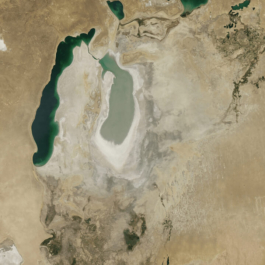
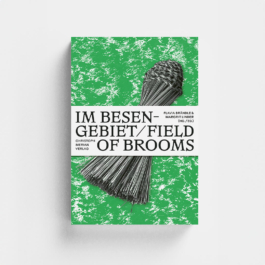
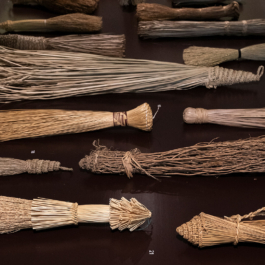
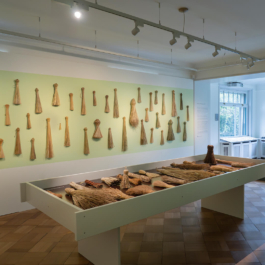
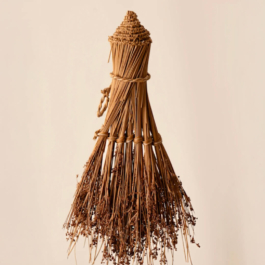
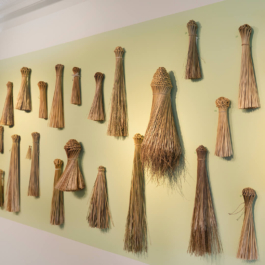

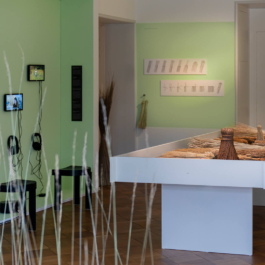
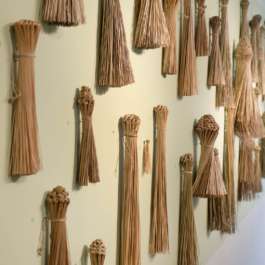
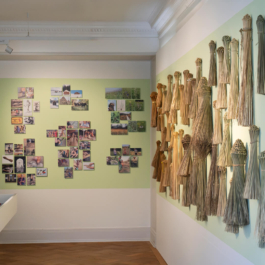
Interdisciplinary Programme for Ecocultural Regeneration
19.01.–30.06.2026
Nukus, Uzbekistan
Proud to announce that I have been awarded a grant for the research-based programme at the Aral Sea.
The climate crisis is leaving an indelible mark on our ecosystems and bioregions, forcing us to rethink our interdependencies and alliances. North Uzbekistan and the Karakalpakstan area were once home to the vast Aral Sea, a lake in Central Asia that was for most of the 20th century the world’s fourth largest saline lake. In the last fifty years, the lake has dramatically dried up, with a radical increase in salinisation, primarily due to unsustainable irrigation practices linked to intensive, large-scale cotton cultivation. The consequences have irreversibly altered a bioregion and caused the collapse of an ecosystem, with serious impact on local communities and the region’s ecology, economy, culture, and public health.
The Aral School is an interdisciplinary postgraduate programme that recognises the unique characteristics of this context, as well as the dramatic consequences of this ecosystem’s collapse. In a lucid approach, the school takes these as the starting point to create new and sustainable visions and prototypes for a shared future. The programme brings together international and local participants from Uzbekistan and Karakalpakstan to explore innovative solutions for cultural and ecological regeneration. Learning from the traditions, biocultural context, and environmental pressure of the Karakalpakstan region, the programme fosters new ways of learning and collaborating across disciplines.
Aral School is commissioned by the Uzbekistan Art and Culture Development Foundation (ACDF), and led by curator and bioregional designer Jan Boelen.
Image credit: NASA via Wikipedia
Publication
⭢ More on book
⭢ Order here
This year, I was invited for a field research and documentation of a broom archetypically unique to the Cyprus tradition. It is finally official and I am excited to share the book project, FIELD OF BROOMS, with you!
Profile of the authors:
Flavia Brändle and Margrit Linder, independently discovered Swiss grass brooms and were captivated by the skillful craftsmanship behind these everyday objects. A closer examination of these brooms took us from local traditions to global contexts and historical insights.
The book will be published by Christoph Merian Verlag in June 2025, experts from various disciplines will explore the fascinating world of bound hand brooms.
The book is available for pre-order or you may find out how you can join our project here.
Exhibition (contribution)
27.04.–01.03.26
Schweizer Strohmuseum
Wohlen, Switzerland
⭢ Link
Just a few decades ago, the grass broom was an indispensable tool in many rural areas of Switzerland. Used in the kitchen, at the front door, or to remove dirt from shoes, its versatility made it an important helper in everyday life. Made from marsh grass, traditionally harvested and produced by women, it was primarily intended for personal use. But it also found its way to markets. However, with the advent of modern plastic brooms and the disappearance of wood-burning stoves, this handmade utensil was forgotten – along with the intricate weaving techniques used to make it.
Together with other designers (including myself), broom collectors, and researchers, we are proud to have contributed to this important exhibition through field research, documentation, and publication on brooms around the world.
The curators Flavia Brändle and Margrit Linder have been working for years to preserve this cultural asset. In the exhibition IM BESENGEBIET, we present the results of our research and invite the public to rediscover the cultural significance and aesthetic quality of this often overlooked everyday object. At the same time, the close link between nature and craftsmanship is brought to life.
•
Image credit: Zoé Ammann
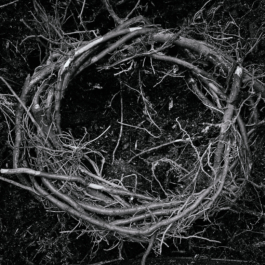
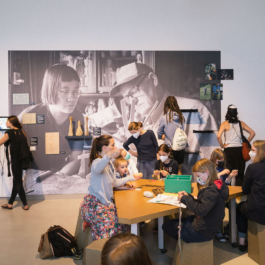
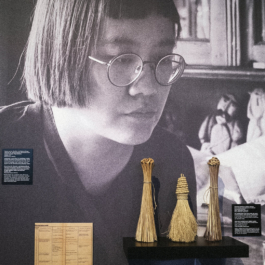
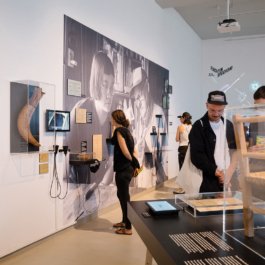
Europe, 2022–ongoing
A long-term research project (field trips, theoretical study, exhibitions, and knowledge transmission) about natural materials and the environmental, social, and cultural challenges they face in the frame of the current climate crisis.
In a world that prioritises industrial materials and production, the use of natural materials has become untenable. They are deemed extractive and undesirably perishable in their quality. The significant use of natural materials has oscillated over time between an extractive movement and questionable longevity. By investigating the traditional craft making, I critically examine today's production practices. Yet another factor with slowness in making necessitates a mindful practice for craftsmanship and care. This practice reminds us of the lost material culture that existed before the industrial era.
From challenging natural materials implied extractive to exploring its resiliency, sustainable potential, and ways to efficiently utilize scarce resources, THE PERISHABLE, SLOWNESS AND KINSHIP seeks to uncover alternative ways to anticipate future ways to produce and its challenges, in which natural systems shape our disciplines. Working with experts from various disciplines, including craftspeople, scientists, policy makers, designers, engineers, and ecologists, they are all united in their desire to become agents of social, ecological, and political change through collaborative and interdisciplinary practices.
#futureofcraft #materialfutures #designresearch
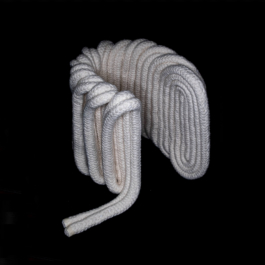
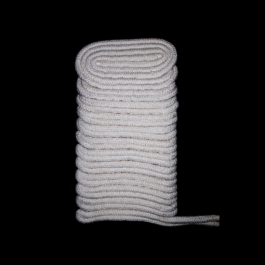
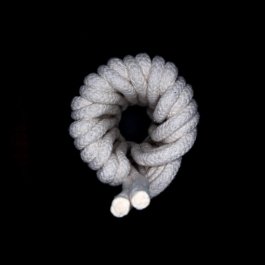

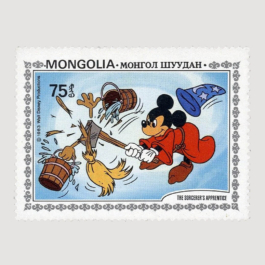
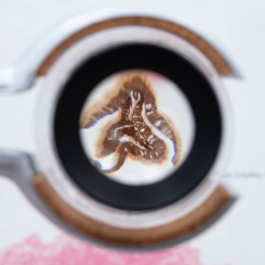
Workshop Supervision
27.–28.10., 03., 25.11.2025
Textile and Material Design Department
Weissensee Academy of Arts and Design Berlin
How can craft practices be reinterpreted as digital tools open up new possibilities for processing materials? What methods and material stories and qualities unfold when combining human-handcraft and robotic-based processes?
This semester-long project explores the intersection of craftsmanship, materials, and computational tools through a combination of lectures, excursions, and hands-on experimentation. Students will engage in two complementary workshops: “Coiling to Tooling” by Evey Kwong, which focuses on coiling as a basketry technique and “Robotic Fabrication” by Kim Cordes, which introduces hybrid, machine-driven processes.
The resulting experiments will be translated into prototypes that range from small samples to scaled objects and structures. Working with materials like grasses, textiles, wood and clay, students will investigate how analog techniques can be interwoven with digital tools, including algorithmic design and robotic fabrication. By experimenting across scales, materials and methodologies, students will explore knowledge systems, discuss the role of craftsmanship in an increasingly techno-centric future and develop new ways of thinking about materials and spatial construction, while reflecting on how traditional and digital technologies can inform one another.
A semester programme supervised by Nayeli Vega Vargas, Maja Avnat, Yolanda Leask.
Workshop Supervision and Lecture
20.–21.11.25
Product and Communication Design Dept.
Karlsruhe University of Arts and Design
⭢ Link
This seminar begins with cleaning: wiping, sorting, deleting. The small acts we do (or avoid) to keep things going. Cleaning is physical and emotional, practical and symbolic. It clears space, reveals systems, creates order or exposes chaos. As routine, as choreography, as gesture. Together we’ll look at cleaning and maintaining as creative, critical, and sometimes absurd practices. We will get our hands dirty, read care labels, exchange household tips and look into broom closets. What does cleaning do to objects, spaces, systems, selves? Isn’t dirt just matter out of place? Can cities become too smooth? Who does all the work? How to remove spilled wax? We’ll respond in our own way. Conceptually, materially, research-based. Come with gloves, parsley between your teeth, with good and bad habits, and unfinished thoughts.
This workshop is supervised by Evey Kwong and is a part of a seminar »Clean air smells funny«, supervised by Lisa Ertel and Jannis Zel.
•
Image credit: “The Sorcerer’s Apprentice”, Fred Moore (1911-1952), Mongolia
Lecture Series
Designing with Biomaterial Intelligence for Sustainable Futures
05.11.2025
⭢ Link
This lecture series is dedicated to the diverse interdisciplinary research of the Cluster of Excellence »Matters of Activity«. The research network, which has been located at the Humboldt University of Berlin since 2019, sheds light on the effects of materials from an active perspective. This fundamentally changes the established understanding of materials as passive, ahistorical substances. Materials are therefore not dead materials, but a living part of our living environment. They connect human and non-human actors, different times and places and carry their own dynamics and implicit memory. »Matters of Activity« combines different expertise from the humanities and natural sciences as well as the design disciplines in order to enable a new perspective on materiality in view of the man-made climate crisis and to show ways to a sustainable material culture.
As part of the lecture series, the researchers will present their projects and results. The topics range from material practices such as weaving, filtering and cutting to the investigation of active material structures and biomaterials to the symbolic dimensions of materiality. The focus of the consideration is in particular questions of collaborative knowledge production and the transmission of scientific findings. At the same time, the lecture provides an insight into the working methods within a cluster of excellence.
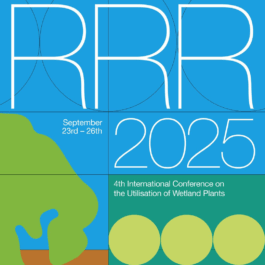
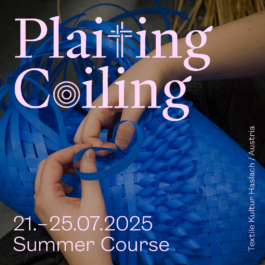

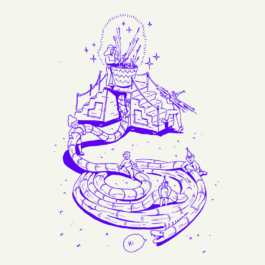
Exhibition
24.09.2025, 5.30–9 pm
Greifswald, Germany
⭢ Link
How can peatland rewetting and innovative land-use concepts be combined for an effective contribution to climate change mitigation? What are innovative examples for creating and strengthening regional value chains? What strategies can overcome barriers and challenges to enable a just transition to sustainable peatland use?
Rewetting supports the nurturing of species of reeds, sedges, and cattails that once flourished in these liquid landscapes, and the sustainable harvesting of crops that thrive in wet peatlands to support human livelihoods (known as ›paludiculture‹)
My work from the project »Swamp Things!« will be exhibited during the conference. The exhibition explores the lively potential of peatland plants as sensuous materials through basketry techniques. Design research and materials science are useful tools for experimenting with the potential of these new and restored biomaterials. This novel material-driven design approach explores the active material properties of these grasses as whole plants rather than shredded biomass, and develops ways of using their fibres to their full potential for as long as possible.
•
Co-organized by Greifswald Mire Centre and Johann Heinrich von Thünen-Institut and funded by Deutsche Forschungsgemeinschaft (DFG)
Teaching: Summer Course
21.07.–25.07.2025
Textile Kultur Haslach, Austria
⭢ Download programme
⭢ Sign up
For this workshop, we will be exploring endless possibilities of basket-weaving techniques with combinations of natural and alternative materials with a thematic approach.
The earliest baskets were made by coiling, twining, twisting and untwisting of plant fibres. Today, baskets are either niche-produced by craftspeople or overlooked as a craft practice. While basketry may no longer be relevant as a medium in and of itself, when combined with other media, it can cleverly hone problem-solving skills in a three-dimensional way. We will focus on coiling and plaiting weaving techniques.
Following two days of hands-on and mental exercises, you will complete a final assignment, realised with techniques you have learned. During the work process, you are free to experiment with different approaches to connecting basket-weaving techniques with your discipline or a theme. Some will make objects based on material experimentation, historical connections, the idea of repair and restoration, or your own design.
What do we imagine when we think about swamps, bogs, fens and peatlands? How and why might swamps come to matter to us, and what stories do we tell about them?
Who among us has experienced being in peatlands, walked across their squelchy, spongy soils, paid attention to their swampy ecologies and learned to recognize the plants and wildlife which thrive there? Many of us live in drained swamps such as that on which Berlin was founded, but few of us recognize the traces of former peatlands, and we are often unaware of their renewed significance for our shared future. Through talks, film, and participation, we will explore what’s at stake in attempts to rewet drained peatlands, the labor entailed in growing, nurturing, and harvesting peatland plants for human use, and how crafting with natural materials such as peatland grasses opens up new ways of understanding ourselves and our environments.
This event brings together diverse approaches to understanding peatland plants and our relationship to them, while surrounded by snaking coils of peatland grasses. These lively ‘swamp things’ are briefly re-wilding the BHROX pavilion – set in the middle of Ernst Reuter Platz, surrounded by a multi-lane roundabout, it echoes earlier visions of the future – from the original modernist architecture of the Bauhaus in the 1920s, to the urban city planner’s dream of an auto-utopia in the 1950s.
No registration needed.
•
Moderator: Lucy Norris, in English
Illustration: Florian Weisz
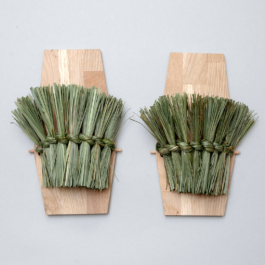

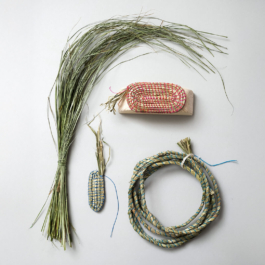
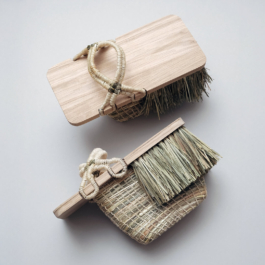
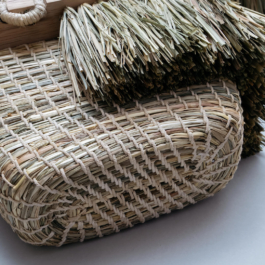
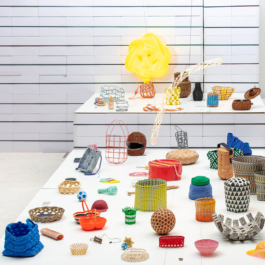
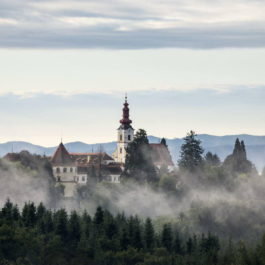

Research, production and exhibition
8–20.07.025
Venue: BHROX bauhaus reuse
Ernst-Reuter-Platz
Berlin
⭢ Link
I am very excited to announce my involvement in the upcoming Matters of Activity year programme of _matter Festival 2025, where I am commissioned as an expert in design for craft technologies.
Together with fellow design and science-led researchers, we are building an exhibition exploring the lively potential of peatland plants as sensuous materials through basketry techniques, open-source coiling machines, and multimodal workshops.
•
Concept: Evey Kwong and Charlett Wenig
Weaving and construction: Evey Kwong
Carpentry work: Lucas Schmidt
Curation: Charlett Wenig and Lucy Norris
Our research on »Swamp Things!« is a collaboration with the Cluster of Excellence »Matters of Activity« at Humboldt-Universität zu Berlin, the Max Planck Institute of Colloids and Interfaces, the Leibniz Institute for Agricultural Engineering and Bioeconomy (ATB), and weißensee academy of art berlin, as part of the _matter Festival 2025.
#SpeculativeDesign #MaterialDesign #PeatlandEcologies #DesignResearch #Science
Workshop Supervision + Lecture
Hochschule für Künste Bremen
16.06. – 19.06.2025
⭢ Link
BEYOND BASKETS is a 4-day workshop, exploring endless possibilities of basket-weaving techniques with combinations of materials and a thematic approach.
The earliest baskets were made by coiling, twining, twisting and untwisting of plant fibres. Today, baskets are either niche-produced by craftspeople or overlooked as a craft practice. While basketry may no longer be relevant as a medium in and of itself, when combined with other media, it can cleverly hone problem-solving skills in a three-dimensional way.
In this workshop, students will learn coiling and plaiting weaving techniques. Following two days of hands-on and mental exercises, students will complete a final assignment, realized with the techniques they have learned.
During the work process, students are free to experiment with different approaches to connecting the basket-weaving techniques with their discipline or a theme. Some of the students will make objects based on material experimentation, historical connections, the idea of repair and restoration, or their own design.
Group Exhibition
03.05.–01.06.2025
Schloss Hollenegg for Design
⭢ Link
My work, ‘Ebb and Flow’ will be showcased at the Schloss! 🌊 The piece tells a story of the connection to my East and Southeast Asian root, reimagined into a handwoven and sewn cultural object. It symbolizes the past (histories), present (diaspora) and the future (the unknown) of my cultural experiences.
•
From the lace-covered handkerchiefs to wall tapestries, the castle is wrapped in fabrics. Textiles are witnesses of technological and societal shifts, carrying our memories and stories. Yet, despite their ubiquity and intimacy, defining what makes a textile remains surprisingly elusive. Is it their flexibility, softness, or the relationship of fibers to one another? Where does a textile begin or end–between the wool on a sheep’s back and the nylon filament of a toothbrush?
Knit and Weave explores these questions through the work of 30 emerging designers who are pushing the boundaries of textile as a medium. Historical textile artefacts from Schloss Hollenegg provide a bridge between past and present, anchoring the exhibition in continuity and innovation. The aim is to inspire audiences with a fresh (and ancient) appreciation for the boundless potential of textiles.
•
Curated by Johanna Pichlbauer with works by Aoi Yoshizawa, Anna Resei, Theresa Hattinger, Alexia Venot, Anneleen Bertels, Billie van Katwijk, Carolin Schelkle, Dila Demircan Ozer + Joy Hsu, Duyi Han, Ege Kökel, Emilie Palle Holm, Esther Van Schuylenbergh, Estelle Bourdet + Mari Koppanen, Franciska Meijers, Fransje Gimbrère, Hana Tavcar, Jane Wright, Lisa Mota, Magdalena Sophie Orland, Marcos Kueh, Paula Holzhauser, Rosana Escobar, Sarah Espeute, Stefan Troendle, Svenja Bremen, Yuval Harel, Zoa Lu Rosenkranz and a special project by Basketclub (Evey Kwong + fellow designers).
Image credit: Leonhard Hilzensauer
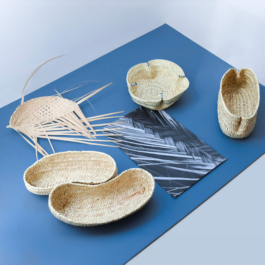
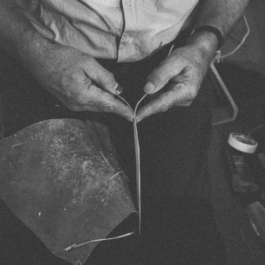

Design in Craft Competition Exhibition
13.03.–17.04.2025
G8 Gallery, Zlín
⭢ Link
The 12th edition of the international crafts-oriented design competition is a platform aimed at finding innovations inspired by traditional craft production. Organized by ÚĽUV since 2000, the competition’s mission is to foster dialogue on traditional values, their preservation and innovation in contemporary craft, applied art and design. It aims to explore possible intersections and encourage cooperation between artisans and professional designers.
My work is part of the selection of the best works entered in the current competition will be presented in the ÚĽUV Bratislava Gallery and will then travel to the G18 Gallery in Zlín and the ÚĽUV Gallery in Košice.
Lecture
27.03.2025
For the Faculty of Design, Burg Giebichenstein Kunsthochschule Halle
Venue: Museum Europäischer Kulturen, Berlin
⭢ Link
They still exist, the wainwrights, coopers, basket makers and blacksmiths, the saddlers, bell founders, stick makers and charcoal burners. But for how much longer and what knowledge is already half in the dark and will soon be completely lost?
In this semester project, we would like to go in search of the last of their guilds. We want to look over their shoulders, listen attentively and explore their profession in an appreciative way in order to find out what people who produce handicrafts can learn about the material world and themselves through their physical and mental engagement with it.
What forgotten stories, experiences, tips and tricks, what special recipes, production methods, traditional techniques and materials do these specialists still have ‘in store’? What equipment, apparatus, devices and tools have they devised to carry out their work? And what role do skill, patience and perseverance, as well as precision and sensitivity, play in manual labour? How are all the senses utilised, stimulated and trained in the creative process and for quality control of a workpiece/material?
Organised by Prof. Vincenz Warnke and Bastian Thürich
Burg Giebichenstein Kunsthochschule Halle
09.12. at 6:00pm
⭢ Link
As a designer and researcher, Evey Kwong provides an overview of her practice-based research, which focuses on the use of crafts as a tool to connect with people and the environments they cohabit. By challenging the formalistic single-discipline practice, she developed an autonomous learning methodology to reinvent new ways of practicing crafts with sensibilities that extend beyond material, technique and product design.
With her years of basket-making explorations between East and West, her works exhibit the value of diversity in understanding the process of making and how transcultural histories can be relevant to address the challenges of social polarization, the growing technological divide between humans and the natural world.
Evey’s work spans design research, exhibition making, hands-on workshops, writing and design commissions. Her work has been exhibited at museums and international design festivals such as the HOW&WOW BASK IT! [organized by Crafts Council Nederland for the Dutch Design Week], Kunstgewerbemuseum Dresden and Fiskars Village Art & Design Biennale.
She holds lectures and hands-on workshops at international art and design universities regularly.
From the week of 9-13th December, she will be giving a workshop, BEYOND BASKETS at the design fundamentals.

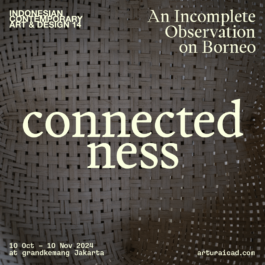

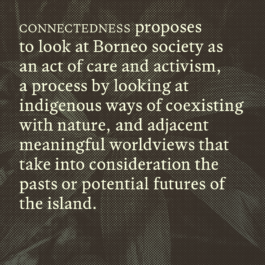
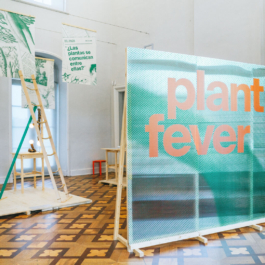
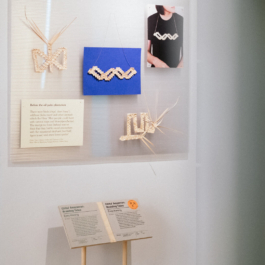
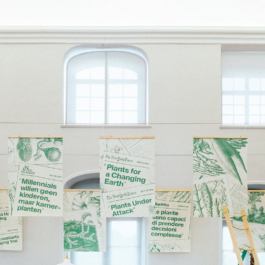
Workshop Supervision
Burg Giebichenstein Kunsthochschule Halle
09.12. – 13.12.2024
⭢ Link
BEYOND BASKETS is a 1-week workshop, exploring endless possibilities of basket-weaving techniques with combinations of materials and a thematic approach.
The earliest baskets were made by coiling, twining, twisting and untwisting of plant fibres. Today, baskets are either niche-produced by craftspeople or overlooked as a craft practice. While basketry may no longer be relevant as a medium in and of itself, when combined with other media, it can cleverly hone problem-solving skills in a three-dimensional way.
In this workshop, students will learn coiling and plaiting weaving techniques. Following two days of hands-on and mental exercises, students will complete a final assignment, realized with the techniques they have learned.
During the work process, students are free to experiment with different approaches to connecting the basket-weaving techniques with their discipline or a theme. Some of the students will make objects based on material experimentation, historical connections, the idea of repair and restoration, or their own design.
Exhibition: Indonesian Contemporary Art and Design
Special Appearance Region: Borneo
grandkemang Jakarta
10.10. – 10.11.2024
⭢ Link
UNEXPECTED, a place where artists and designers are invited to look into history and present conditions of our society, and reformulate them with their imagination. As if lending the role of world-builders to them, they are invited to speculate their relationship with the realities that surround them to speculate alternatives to the past, or possible futures. What should our concerns and creations gesture towards, given the distorted and unforeseen realities that surround us?
ICAD selects seven distinguished designers and cultural practitioners for ‘Special Appearance’ with the idea of honouring or paying tribute to their work. The category sheds light on Borneo as an island shared by both Indonesia and Malaysia. Reflections on the notion of crafts, borders, land, and environmental changes are highlighted through art, design, sound, and socially engaged works.
Group Exhibition
Kunstgewerbemuseum Dresden
Schloss & Park Pillnitz
27.04. – 03.11.2024
⭢ More on project
⭢ Visitors’ Info
🌱 The multi-year research and exhibition project PLANT FEVER addresses current debates on the topic of sustainability, the relationship between humans and plants, and our use of resources. The exhibition argues for a profound rethinking of our relationship with the vegetal world and opens up a space to link art, science and ecology. Pillnitz Palace & Park offers a unique complement to this approach due to the horticultural tradition that has historically grown in Pillnitz.
Ranging from products and fashion items to material research, open-source devices and emerging technologies, my work, “Chita’ Anyaman. Braiding Tales” will be featured alongside 50+ projects, representing the work of creatives from more than 20 countries.
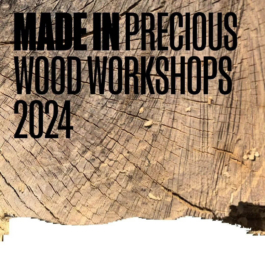
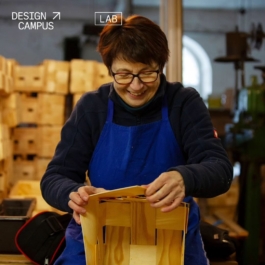
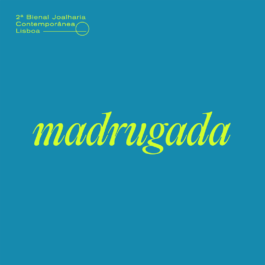
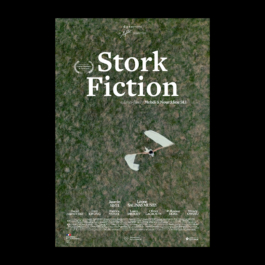
Learning: Design Workshop
Schneeberg, Germany
23.09. – 27.09.2024
⭢ More on workshop
I will be participating on the upcoming design workshop by MADE IN. The workshops provide the younger generation of designers, craftspeople and other creatives the possibility to explore the material wood in an experimental way guided by mentors encouraging with their supportive skills in the field of engineering, craft and design. Lectures, workshops and field trips help to create an entirely creative journey giving a glimpse of what a design study or a craft training might look like.
The objective is to push the boundaries of what the material wood and its processing methods can be used for in the twenty-first century in a beautiful, intelligent and compelling way. Furthermore, the workshops will bring together a younger generation with craftspeople and design mentors, celebrating a multidisciplinary way of sharing knowledge. The structure of the workshops fosters the development of collaborative creative proposals by taking advantage of the aesthetic as well as functional characteristics of the different raw materials and techniques.
The participants will create a series of completed exhibition-quality pieces, as well as expressive studies and prototypes that will be presented in two exhibitions in Ljubljana, Slovenia and in Schneeberg, Germany in 2025.
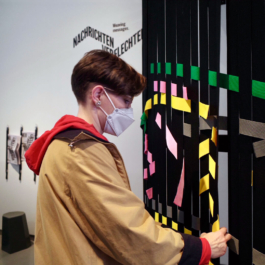

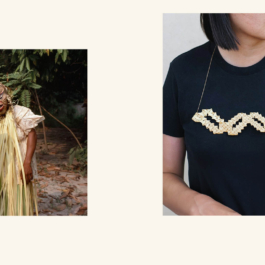
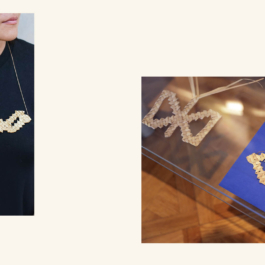
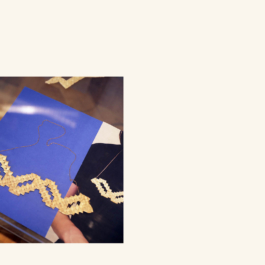
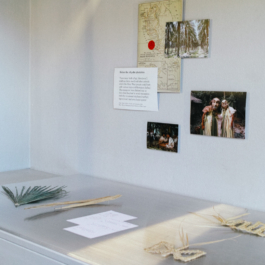
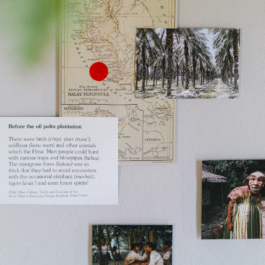
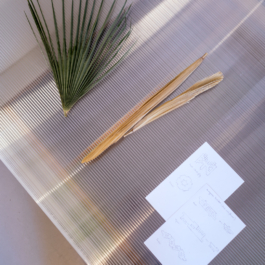
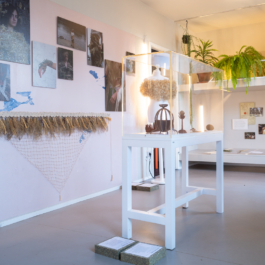
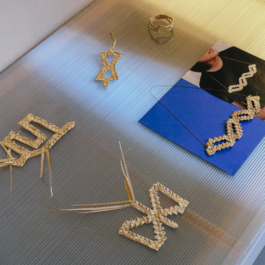
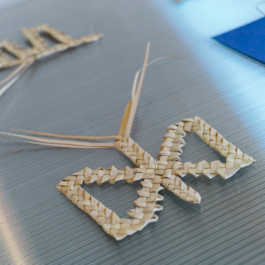
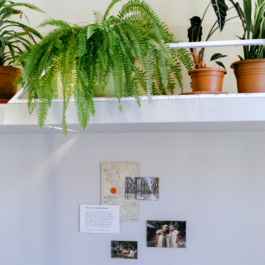
Happy to share that my work will be part of Vienna Design Week with an installation presenting a selection of works produced during this’s School of Phyto-centred Design organised by the Kunstgewerbemuseum Dresden. ROOM FOR CHANGE is an invitation to change perspective, question harmful agricultural practices, and look at plants as allies for militant and poetic design scenarios. Showcasing material experiments, fashion items, products, performances as well as videos and photos, the installation highlights the design and narrative potential of plants and reveals stories of interdependence, empowerment, resilience, but also exploitation, overconsumption, and colonization.
•
Other featured works by: Archeomaterico, Deborah Tina, Sahrajajarmikhayat, Anojish Kariano, Jaqueline Lobodda, Chi.makes.jewelry, Sujia Wang, morgennacht (art direction by Emma Bruschi) Kareem Goshan, Katoy Design, Benedikt Trojer (art direction by Fernando Laposse) / Natalia Milla / Katharina Ursula Mludek, Katrin Schwarz, Julia Sulikowska. Special thanks to Thomas Geisler for inviting us, and to Jasmin Schauer for the smooth coordination.
•
Image credit:
[1] Mah Meri girls get ready for dancing for tourists”, Carey Island, Bemboun Village, Carey Island, Malaysia, 1990, Jean Gaumy.*
[2–3] Leonie Hochstrasser
*This project is a non-commercial project. The pictures used are for educational and research purposes only.
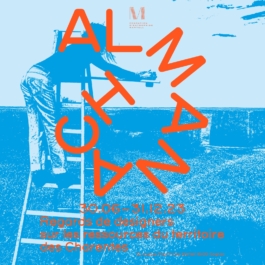
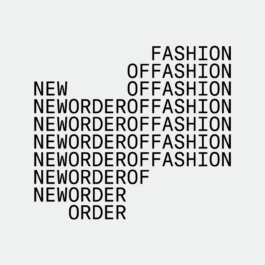
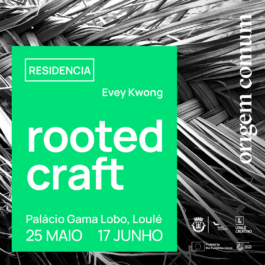
The Almanac exhibition is the inaugural research project of Fondation d’entreprise Martell, which, since its inception five years ago, is now evolving into a research and experimentation platform for art and design, as well as a space for raising awareness and learning – with a focus on living things.
This experimental initiative, which takes the form of an exhibition, residencies, encounters, and a living archive laboratory, emerged from a reflection on how a foundation located in a context that is rural yet industrial, prosperous yet remote, can establish itself as an agent for local dynamism and activate new potential for collective transformation. It soon became clear that the first step, before taking any action, would require the compilation of an inventory of the region’s resources and issues.
A team of designers was assigned with an investigative mission involving a wide range of local contacts (institutions, businesses, professional networks, and residents of Charente and Charente-Maritime), to identify local resources – natural and industrial, tangible and intangible.
The team led by Olivier Peyricot with Lola Carrel, Valentin Patis, and Mathilde Pellé, established an investigative methodology before embarking on the collection and analysis work.
The subjective view resulting from their observations is presented on the second floor of the Foundation. It offers an immersion into the collected samples, enabling visitors to rediscover significant materials and neglected deposits, living techniques, and forgotten know-how.
This multi-faceted and contributory project explores the processes of production and interdependence in order to better position itself as a tool and catalyst for transition, enabling the development of unique creative practices that bring about change. The aim is to create new imaginaries and chart new ways for building a resilient and equitable future.
New Order of Fashion (NOoF) invites (aspiring) fashion design professionals to join us for an invigorating week-long programme exploring the knowledge and skills we need for a better fashion future!
The ‘Design for Change’ retreat addresses the contemporary issues fashion faces: on climate, environment, production, consumption, and wellbeing for people. Through a combination of theory and hands-on exercises, we’ll examine the various paths that can be taken to a cleaner, smarter and more caring fashion future.
Together with a stellar line up of international speakers, experts and workshop hosts, we will collectively investigate the overarching goal of sustainable and circular fashion design. The program includes topics and methodologies such as systemic thinking, local regeneration, material understanding & value, crafts, remake and repair skills, and building resilient communities.
‘Rooted Craft’ is a research project that explores rural crafts with a new approach to weaving techniques that were once a thriving economic activity for agricultural and transportation of goods, as well as for domestic use. With the scarcity of natural resources and environmental awareness, there is a resurgence of artisanal production, recovering ancestral technologies.
The resulting products answer the demand for more ecological consumption choices. With that in mind, this project looks to form new hybrid understandings of weaving, through know-how exchange and transfer and weaving archetypes research to open new possibilities for new applications. In result of these rich archives, they will be integrated in the ‘Situated Practices’ exhibition.
⭢ More on project
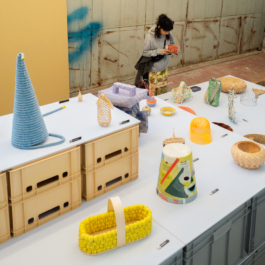
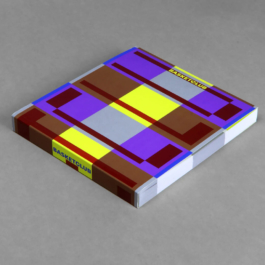
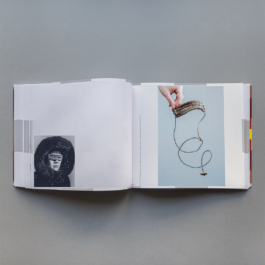


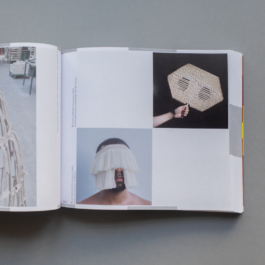

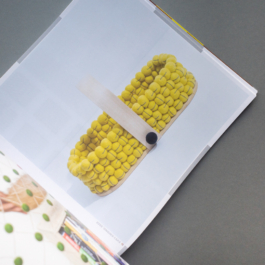
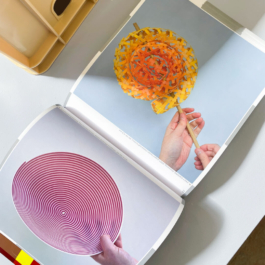
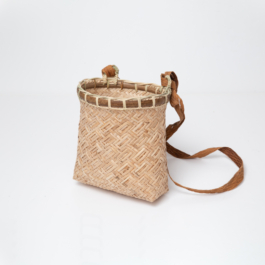
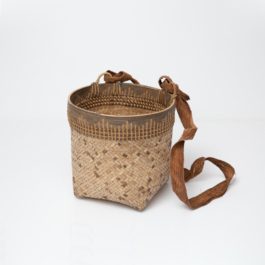
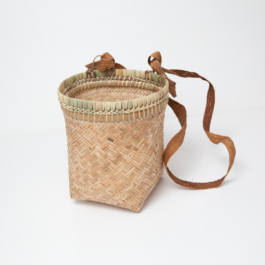
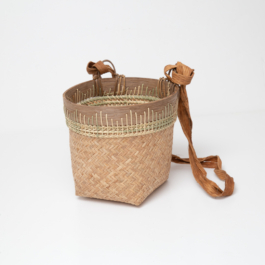
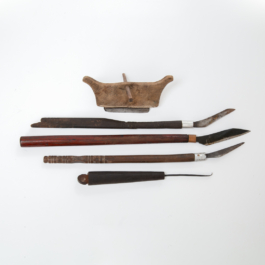
Feature works on publication, 2023
⭢ Link
Together with designers and crafts makers from diverse backgrounds (product, textile and graphic design, design anthropology, crafts making, etc.), I am thrilled to be part of this initiative as this way of working has shaped me the past years of my practice as a designer and my work methodology via acknowledging the history of low-tech crafts and the material design.
The instagram-based group Basketclub was founded during the pandemic by Dutch designer Adrianus Kundert and Canadian designer Jamie Wolfond with the idea of empowering experimental making during the difficult times. Each member of Basketclub weaves a basket based on an emoji.
To celebrate three years of Basketclub, and the 300+ baskets made for the project, the book was launched during Salone del Mobile last year. The baskets shown represent a range of different approaches, including technical, aesthetic, conceptual, playful, political, and historical. Each designer brings their unique fascination and cultural context to the theme.
•
The book, designed by Koos Breen, and edited by Adrianus Kundert has 312 full color pages with images of all the basketry projects and includes essays by Ed van Hinte, Adrian Madlener and Lois Walpole.
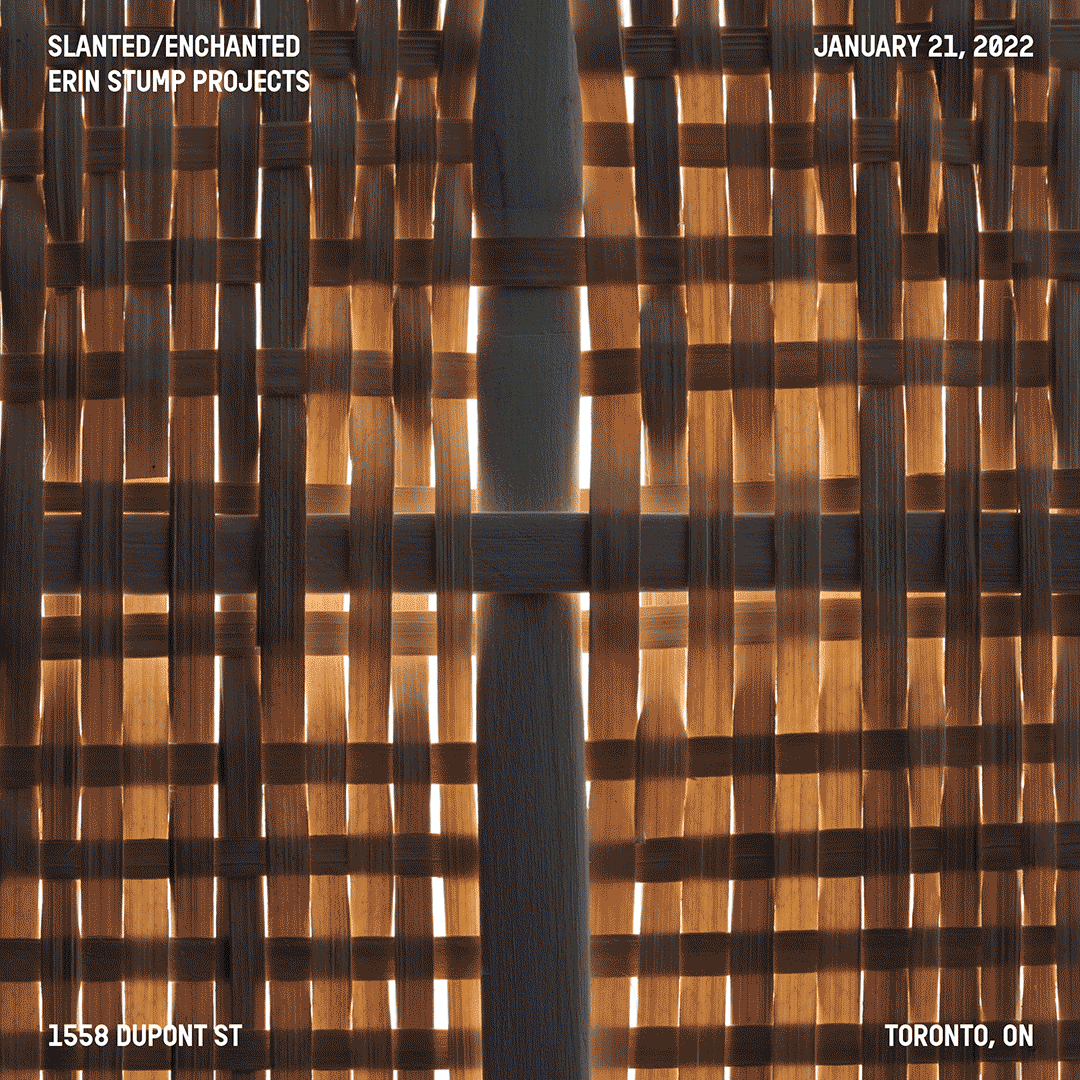

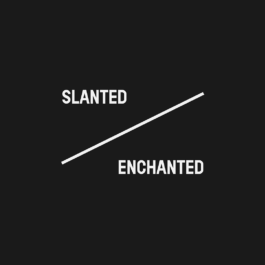
Group Exhibition
Erin Stump Projects, Toronto
Jan 21–Feb 26, 2023
⭢ Link
In the studio, designers frequently use ad hoc processes to represent industrial ones, but often these improvised methods are more interesting than the ones they represent. The purpose of this show is for participants to engage in experimental crafts which may fall outside the traditional canon of their discipline.
This event takes place in conjunction to the Design Week Toronto.
#reinterpreting #traditionalobjects
Organisation by Jamie Wolfond and Rebecca Collins. 📸 by Sean Davidson and graphic design by Soleil Singh.
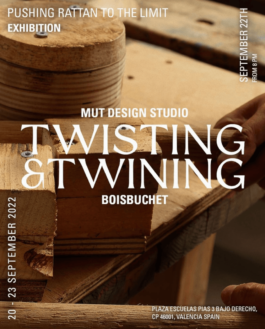
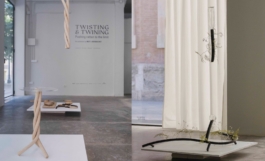


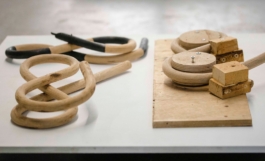
Group Exhibition
World Design Capital Valencia
Sept 19–25, 2022
⭢ Link
Rattan is a humble material, but extremely rich in shades. Obtained from the processing of certain species of climbing palms mostly found in Asia and Africa, rattan is fine, durable, sturdy while visually lightweight. Similar materials, such as wicker, esparto and cane, have been used since ancient times, especially in the rural environments, to produce both decorative and daily-life functional objects, such as baskets, espadrilles, mats, and seats. It has long been widely used in the field of design, too.
The exhibition features the results of the 1-week Summer workshop which took place at Domaine de Boisbuchet. During the workshop, we focused on rattan’s properties and explore all the different ways and possibilities to work with it, pushing it to its limits. Our hands will be very busy in weaving and bending, twisting and twining (with the help of a steamer at our side to shape our ideas).
Participants: Anton Rahlwes, Carla Alcalà Badias, Evey Kwong, Gonçalo Lopes Cardos, Isabel Alonso, Lucia Sanchis and Nic Holden.
Material sponsorship by Expormim. Photos by Nacho García.
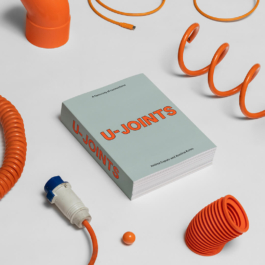
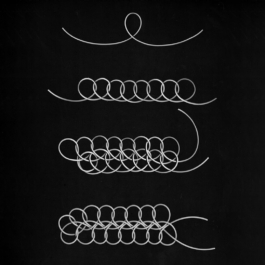
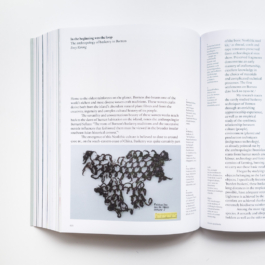
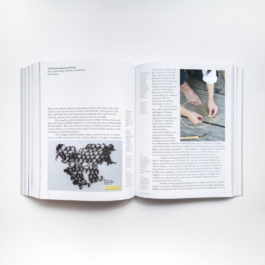
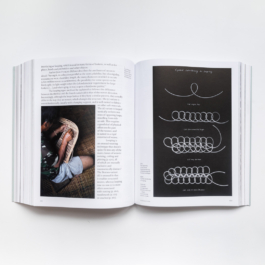
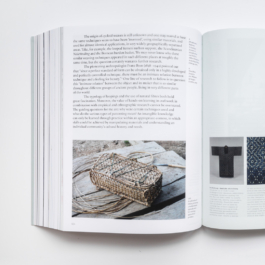
Research and Writing, 2022
Essay “In the beginning was the loop. The anthropology of basketry in Borneo.”
by Evey Kwong
The volume looks at human history through its details, and invites us to see design and architecture in new ways. Comprehensive and interdisciplinary, U-JOINTS is a collective project that brings together the voices and viewpoints of more than 120 authors. Together they “tell” design and architecture in the form of stories, essays, interviews, statements, visits to factories, reportage, facts and figures and, not least, a vast taxonomy of joints. Photo portfolios examine how joints are produced, illustrate their diverse uses, or simply show the inherent yet often overlooked beauty of connections in the man-made world.
Editors: Andrea Caputo, Anniina Koivu
Editorial team: Margherita Banchi, Marta Pezzoli
Senior researcher: Eleonora Castellarin
Design: Graphic Thought Facility
Printed and bound by: Musumeci Spa
Publisher: SYNC-SYNC Editions
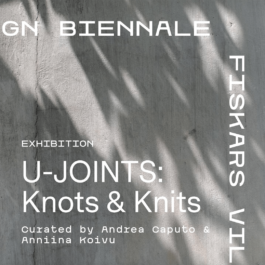
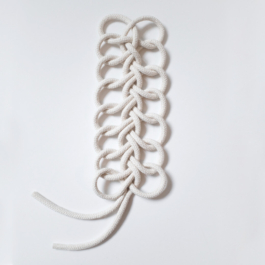
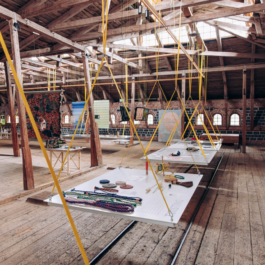

U-Joints – Knots & Knits is a glimpse into the manifold possibilities of intrinsic connections, unravelling the history of textiles, fabrics and ropework. Whether used in rigging, for lifting heavy objects, wrapping a lunch box or closing a gift, securing a funambulist’s highwire, keeping a climber from falling off a wall or creating adventurous playgrounds for children, knots are considered the oldest and most basic technique of joinery. Bridges, bamboo scaffoldings, fishing nets: all kinds of structures can trace their origins to the simple gesture of pulling a string through a loop. Knitting, in turn, creates anything from clothing to car interiors to entire architectural structures. When strings are intricately crossed, woven patterns are born.
In the form of upholstery weaves, they lend comfort to our sofas, can buffer noise or explode into life-saving airbags. Electric cables, airplane wings and morphing membranes for vascular prostheses can be woven. Clothing and home textiles are unimaginable without weaving. Decorative tapestries cover walls to keep out the cold, while knitted, knotted, hooked and woven carpets and rugs cover floors and warm our feet. Woven wicker, rattan or birch bark creates baskets, chairs or shoes. Seamstresses master stitching in sewing work. Surgeons practice stitching for closing wounds. Women embroidered each night after dinner, whether for leisure or work. Needlework was used to embellish dresses or to stitch mischievous political messages into a piece of cloth.But the use of knits and knots is by no means old-fashioned: not long ago, a computer’s core memory was stitched, as are today, books, sneakers and NASA’s equipment for space.
Featured joint projects by Anni Albers, Luisa Cevese, Clifford Ashley, Carole Baijngs, Estelle Bourdet, Ronan and Erwan Bouroullec, You-Chia Chen, Rebecca Collins, Dach and Zephir, Pete Decker, Pauline Deltour, Earnest Studio, Pierre Fouché, Shigeki Fuijshiro, Kai Hesari, Joseph-Marie Jacquard, Kate Jenkins, Ýr Jóhannsdóttir, Hella Jongerius, Chris Kabel, Karhu, Markku Kosonen, Wataru Kumano, Adrianus Kundert, Evey Kwong, Maria Lai, Ada Lovelace, Robin Pleun Maas, Outi Martikainen, Mary Queen of Scots, Masayoshi Matsumoto, Christien Meindertsma, Aino Michelsen, Thomas Missé, Takao Momiyama, Bruno Munari, Matilda Palmu, Gaetano Pesce, Philippe Petit, Tau Pibernat and Vera Castelijns, Irene Posch, Simone Post, Bertjan Pot, Rein Reitsma, Samy Rio, Garth Roberts, Marialaura Rossiello/Studio Irvine, Adrien Rovero, Kustaa Saksi, Katrina Sánchez Standfield, Brynjar Sigurðarson, Mikko Snellman, Ief Spincemaille, Peter Steinhauer, Studio Sanne Visser, Kiki van Eijk, Joep Verhoeven, Milou Voorwinden, Ulla-Stina Wikander, Marcel Wanders, Jamie Wolfond, Zaven.
In collaboration with Luovi Productions Kari Korkman, Helena Fernström, Anni Korkman, Iris Korkman, Rania Taina, Neea Rautio, Lauri Johansson.

The whisk brooms from my crafts research has found its new home in the Berlin State Museum collection. In conjunction to the upcoming exhibition All Hands On: Basketry, the brooms will be showcased along with the impressions of my past learning experiences with Carlos Fontales (ES), Serfenta (PL), Margrit Linder (CH) and in Borneo.
From left to right: Brooms techniques found from Habkern, Uri and Murcia. Made by Evey Kwong. © Staatliche Museen zu Berlin, Museum Europäischer Kulturen, Christian Krug
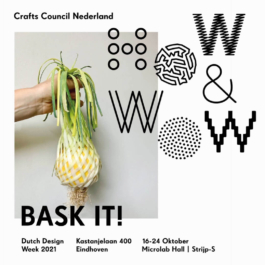
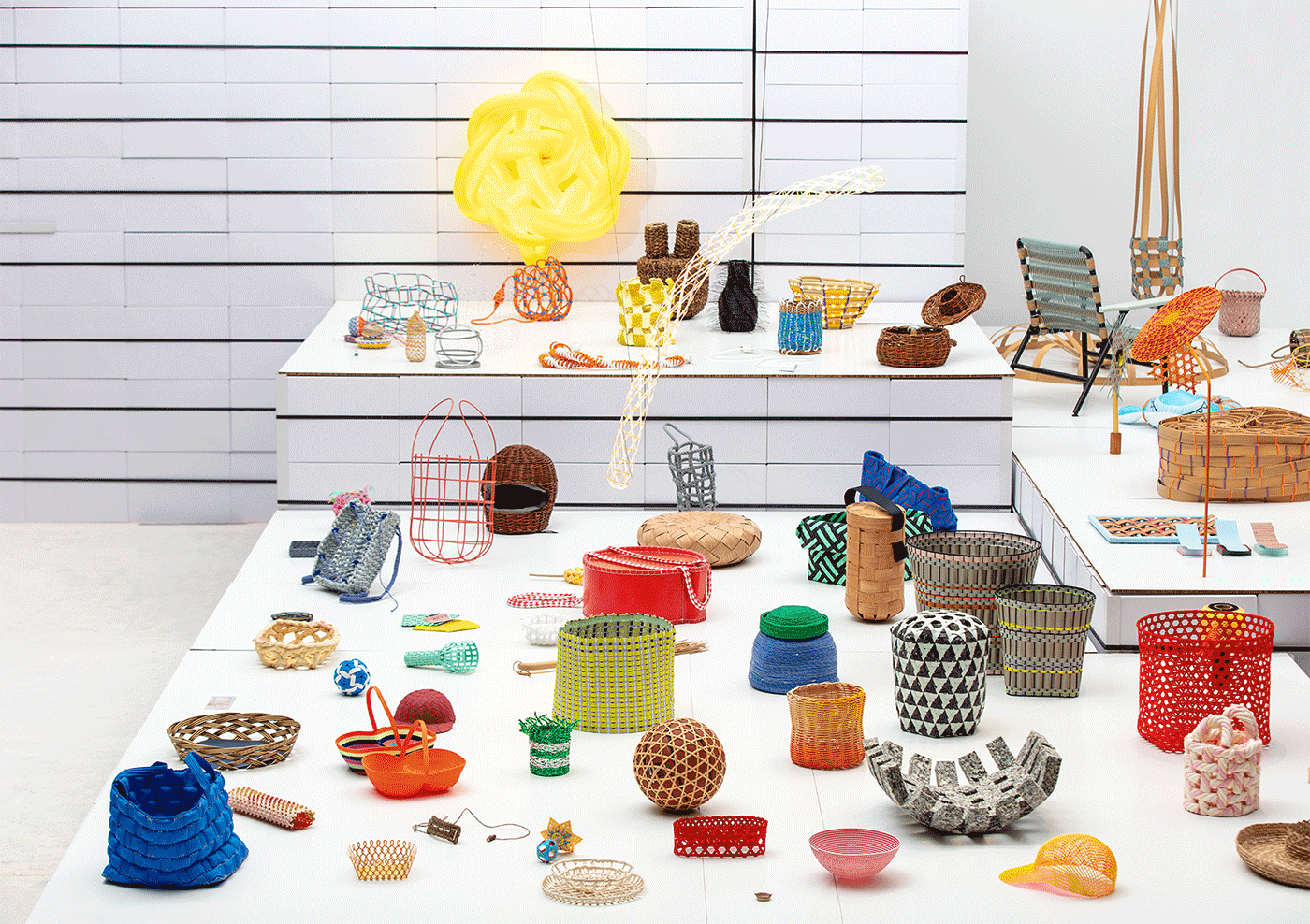
Group Exhibition
An initiative of Crafts Council Nederland in collaboration with Adrianus Kundert, designer and co-founder of Basketclub.
HOW&WOW BASK IT! – or ‘treasure it’ – will transport you into the world of basketry and reveal the numerous aspects of three dimensional weaving: the specific characteristics, creative techniques, new implementations, cultural exchange and nature conservation. Basket weaving is a 3D-construction technique allowing the maker to create a three dimensional shape using their own hands and just a few tools. The craft, and also its importance, have undergone changes through time. Few people realise that all woven baskets, furniture and accessories are still made by hand, including those sold by the well-known retail chains. Lack of appreciation for this time consuming technique has resulted in it now rarely being practiced in the western world. It is particularly important to focus on the unique characteristics of hand made products in the current era of globalisation, digitalisation and robotics. Craftsmanship is satisfying work, makers are in control of what they produce and are able to express their individuality. It is no surprise that the online community Basketclub arose during the pandemic.
Participants: Adrianus Kundert, Amandine David, Anaïs Godefroy, Bertjan Pot, Carole Baijings, Chris Kabel, Christopher Specce, Clara von Zweigbergk, dach&zephir, Earnest Studio, Emma Cogné, Esmé Hofman, Esther van Schuylenbergh, Evey Kwong, Fango, Garth Roberts, GREATMINOR, Hella Jongerius, Hsiao Fong, Ief Spincemaille, Ineke van der Sommen, Jamie Wolfond, Joris van Tubergen, Léa Mazy, Lenny Stöpp, Lois Walpole, LouCruard, Mae Engelgeer & Ames, Mandenmakerij de Mythe, Michael Schoner, Nathalie Miebach, Nationaal Vlechtmuseum Noordwolde, Rebecca Collins, Rein Reitsma, Renaud Defrancesco & Anne Bertoncini, Rik van Veen, Rob van Hernen, Samy Rio, SCMP DESIGN OFFICE, Sebastian Herkner, Shigeki Fujishiro, Simone Post, Studio Satël, Tamara Orjola, Thomas van der Sman and Yuki Hidano.
Team Crafts Council Nederland: Marion Poortvliet, Willemien Ippel & Guusje Heesakkers
Curator: Adrianus Kundert
Graphic design: Daniël Maarlevel
Photo credit: Fan Liao
HOW&WOW BASK IT! is financially made possible by Creative Industries Fund NL, Prins Bernhard Cultuurfonds and Dedon.
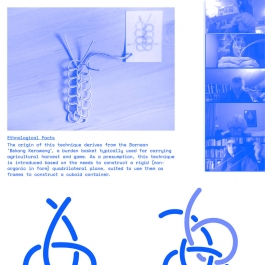
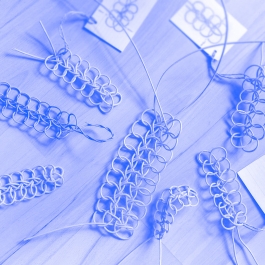
The origin of this technique derives from the Bornean ‘Bekang Kerawang’, a burden basket typically used for carrying agricultural harvest and game. As a presumption, this technique is introduced based on the needs to construct a rigid (non-organic in form) quadrilateral plane, suited to use them as frames to construct a cuboid container.

Interdisciplinary Programme for Ecocultural Regeneration
19.01.–30.06.2026
Nukus, Uzbekistan
Proud to announce that I have been awarded a grant for the research-based programme at the Aral Sea.
The climate crisis is leaving an indelible mark on our ecosystems and bioregions, forcing us to rethink our interdependencies and alliances. North Uzbekistan and the Karakalpakstan area were once home to the vast Aral Sea, a lake in Central Asia that was for most of the 20th century the world’s fourth largest saline lake. In the last fifty years, the lake has dramatically dried up, with a radical increase in salinisation, primarily due to unsustainable irrigation practices linked to intensive, large-scale cotton cultivation. The consequences have irreversibly altered a bioregion and caused the collapse of an ecosystem, with serious impact on local communities and the region’s ecology, economy, culture, and public health.
The Aral School is an interdisciplinary postgraduate programme that recognises the unique characteristics of this context, as well as the dramatic consequences of this ecosystem’s collapse. In a lucid approach, the school takes these as the starting point to create new and sustainable visions and prototypes for a shared future. The programme brings together international and local participants from Uzbekistan and Karakalpakstan to explore innovative solutions for cultural and ecological regeneration. Learning from the traditions, biocultural context, and environmental pressure of the Karakalpakstan region, the programme fosters new ways of learning and collaborating across disciplines.
Aral School is commissioned by the Uzbekistan Art and Culture Development Foundation (ACDF), and led by curator and bioregional designer Jan Boelen.
Image credit: NASA via Wikipedia

Publication
⭢ More on the book
⭢ Order here
This year, I was invited for a field research and documentation of a broom archetypically unique to the Cyprus tradition. It is finally official, and I am excited to share the book project, FIELD OF BROOMS, with you!
Profile of the authors:
Flavia Brändle and Margrit Linder independently discovered Swiss grass brooms and were captivated by the skillful craftsmanship behind these everyday objects. A closer examination of these brooms took us from local traditions to global contexts and historical insights.
The book will be published by Christoph Merian Verlag in June 2025, and experts from various disciplines will explore the fascinating world of bound hand brooms.
The book is available for pre-order, or you may find out how you can join our project here.








Exhibition (contribution)
27.04.–01.03.26
Schweizer Strohmuseum
Wohlen, Switzerland
⭢ Link
Just a few decades ago, the grass broom was an indispensable tool in many rural areas of Switzerland. Used in the kitchen, at the front door, or to remove dirt from shoes, its versatility made it an important helper in everyday life. Made from marsh grass, traditionally harvested and produced by women, it was primarily intended for personal use. But it also found its way to markets. However, with the advent of modern plastic brooms and the disappearance of wood-burning stoves, this handmade utensil was forgotten – along with the intricate weaving techniques used to make it.
Together with other designers (including myself), broom collectors, and researchers, we are proud to have contributed to this important exhibition through field research, documentation, and publication on brooms around the world.
The curators Flavia Brändle and Margrit Linder have been working for years to preserve this cultural asset. In the exhibition IM BESENGEBIET, we present the results of our research and invite the public to rediscover the cultural significance and aesthetic quality of this often overlooked everyday object. At the same time, the close link between nature and craftsmanship is brought to life.
•
Image credit: Zoé Ammann




Europe, 2022–ongoing
A long-term research project (field trips, theoretical study, exhibitions, and knowledge transmission) about natural materials and the environmental, social, and cultural challenges they face in the frame of the current climate crisis.
In a world that prioritises industrial materials and production, the use of natural materials has become untenable. They are deemed extractive and undesirably perishable in their quality. The significant use of natural materials has oscillated over time between an extractive movement and questionable longevity. By investigating the traditional craft making, I critically examine today's production practices. Yet another factor with slowness in making necessitates a mindful practice for craftsmanship and care. This practice reminds us of the lost material culture that existed before the industrial era.
From challenging natural materials implied extractive to exploring its resiliency, sustainable potential, and ways to efficiently utilize scarce resources, THE PERISHABLE, SLOWNESS AND KINSHIP seeks to uncover alternative ways to anticipate future ways to produce and its challenges, in which natural systems shape our disciplines. Working with experts from various disciplines, including craftspeople, scientists, policy makers, designers, engineers, and ecologists, they are all united in their desire to become agents of social, ecologica,l and political change through collaborative and interdisciplinary practices.
#futureofcraft #materialfutures #designresearch

Workshop Supervision and Lecture
20.–21.11.25
Product and Communication Design Dept.
Karlsruhe University of Arts and Design
⭢ Link
This seminar begins with cleaning: wiping, sorting, deleting. The small acts we do (or avoid) to keep things going. Cleaning is physical and emotional, practical and symbolic. It clears space, reveals systems, creates order or exposes chaos. As routine, as choreography, as gesture. Together we’ll look at cleaning and maintaining as creative, critical, and sometimes absurd practices. We will get our hands dirty, read care labels, exchange household tips and look into broom closets. What does cleaning do to objects, spaces, systems, selves? Isn’t dirt just matter out of place? Can cities become too smooth? Who does all the work? How to remove spilled wax? We’ll respond in our own way. Conceptually, materially, research-based. Come with gloves, parsley between your teeth, with good and bad habits, and unfinished thoughts.
This workshop is supervised by Evey Kwong and is a part of a seminar »Clean air smells funny«, supervised by Lisa Ertel and Jannis Zel.
•
Image credit: “The Sorcerer’s Apprentice”, Fred Moore (1911-1952), Mongolia

Lecture Series
Designing with Biomaterial Intelligence for Sustainable Futures
05.11.2025
⭢ Link
This lecture series is dedicated to the diverse interdisciplinary research of the Cluster of Excellence »Matters of Activity«. The research network, which has been located at the Humboldt University of Berlin since 2019, sheds light on the effects of materials from an active perspective. This fundamentally changes the established understanding of materials as passive, ahistorical substances. Materials are therefore not dead materials, but a living part of our living environment. They connect human and non-human actors, different times and places and carry their own dynamics and implicit memory. »Matters of Activity« combines different expertise from the humanities and natural sciences as well as the design disciplines in order to enable a new perspective on materiality in view of the man-made climate crisis and to show ways to a sustainable material culture.
As part of the lecture series, the researchers will present their projects and results. The topics range from material practices such as weaving, filtering and cutting to the investigation of active material structures and biomaterials to the symbolic dimensions of materiality. The focus of the consideration is in particular questions of collaborative knowledge production and the transmission of scientific findings. At the same time, the lecture provides an insight into the working methods within a cluster of excellence.
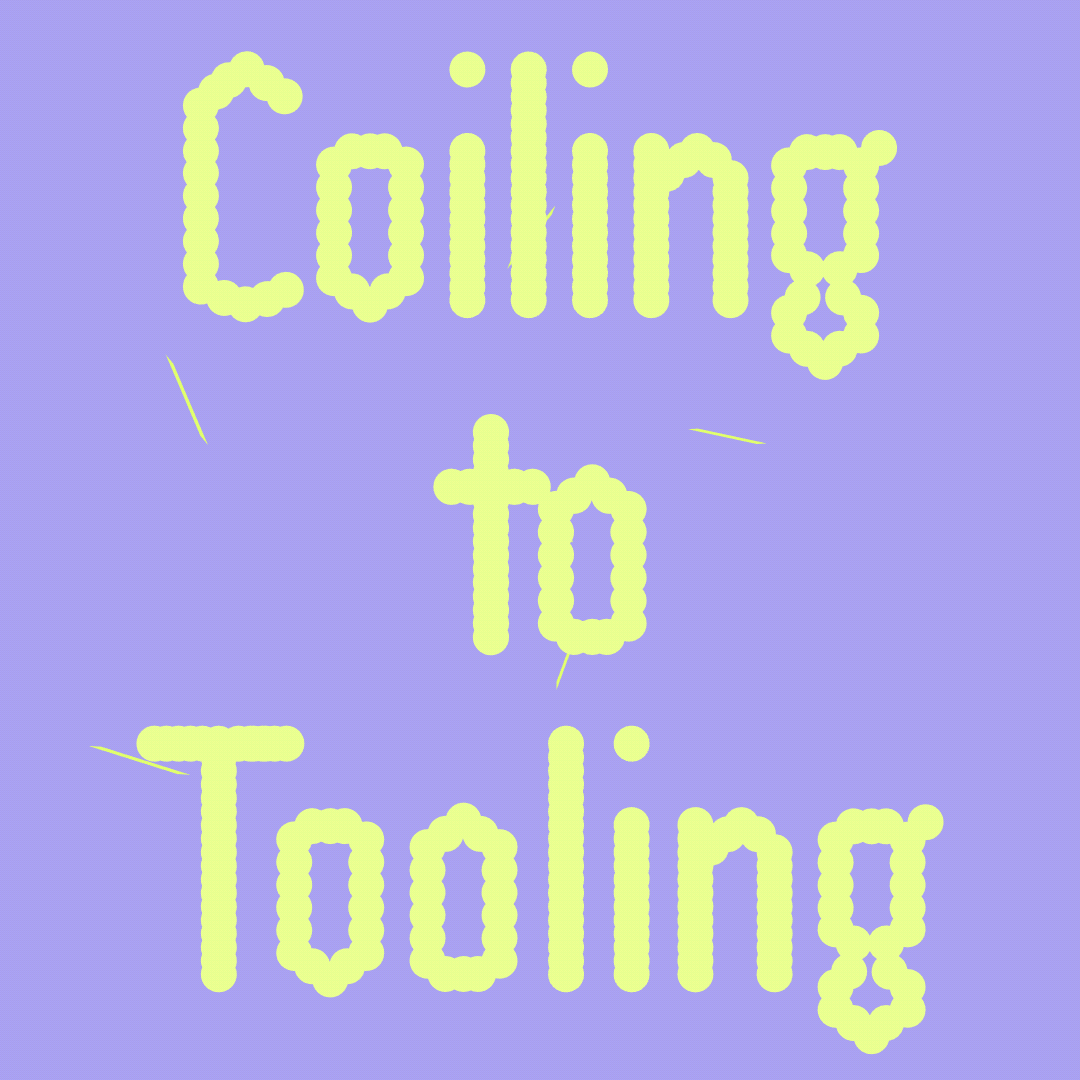




Workshop Supervision
27.–28.10., 03., 25.11.2025
Textile and Material Design Department
Weissensee Academy of Arts and Design Berlin
How can craft practices be reinterpreted as digital tools open up new possibilities for processing materials? What methods and material stories and qualities unfold when combining human-handcraft and robotic-based processes?
This semester-long project explores the intersection of craftsmanship, materials, and computational tools through a combination of lectures, excursions, and hands-on experimentation. Students will engage in two complementary workshops: “Coiling to Tooling” by Evey Kwong, which focuses on coiling as a basketry technique and “Robotic Fabrication” by Kim Cordes, which introduces hybrid, machine-driven processes.
The resulting experiments will be translated into prototypes that range from small samples to scaled objects and structures. Working with materials like grasses, textiles, wood and clay, students will investigate how analog techniques can be interwoven with digital tools, including algorithmic design and robotic fabrication. By experimenting across scales, materials and methodologies, students will explore knowledge systems, discuss the role of craftsmanship in an increasingly techno-centric future and develop new ways of thinking about materials and spatial construction, while reflecting on how traditional and digital technologies can inform one another.
A semester programme supervised by Nayeli Vega Vargas, Maja Avnat, Yolanda Leask.

Exhibition
24.09.2025, 5.30–9 pm
Greifswald, Germany
⭢ Link
How can peatland rewetting and innovative land-use concepts be combined for an effective contribution to climate change mitigation? What are innovative examples for creating and strengthening regional value chains? What strategies can overcome barriers and challenges to enable a just transition to sustainable peatland use?
Rewetting supports the nurturing of species of reeds, sedges, and cattails that once flourished in these liquid landscapes, and the sustainable harvesting of crops that thrive in wet peatlands to support human livelihoods (known as ›paludiculture‹)
My work from the project »Swamp Things!« will be exhibited during the conference. The exhibition explores the lively potential of peatland plants as sensuous materials through basketry techniques. Design research and materials science are useful tools for experimenting with the potential of these new and restored biomaterials. This novel material-driven design approach explores the active material properties of these grasses as whole plants rather than shredded biomass, and develops ways of using their fibres to their full potential for as long as possible.
•
Co-organized by Greifswald Mire Centre and Johann Heinrich von Thünen-Institut and funded by Deutsche Forschungsgemeinschaft (DFG)

Teaching: Summer Course
21.07.–25.07.2025
Textile Kultur Haslach, Austria
⭢ Download programme
⭢ Sign up
For this workshop, we will be exploring endless possibilities of basket-weaving techniques with combinations of natural and alternative materials with a thematic approach.
The earliest baskets were made by coiling, twining, twisting and untwisting of plant fibres. Today, baskets are either niche-produced by craftspeople or overlooked as a craft practice. While basketry may no longer be relevant as a medium in and of itself, when combined with other media, it can cleverly hone problem-solving skills in a three-dimensional way. We will focus on coiling and plaiting weaving techniques.
Following two days of hands-on and mental exercises, you will complete a final assignment, realised with techniques you have learned. During the work process, you are free to experiment with different approaches to connecting basket-weaving techniques with your discipline or a theme. Some will make objects based on material experimentation, historical connections, the idea of repair and restoration, or your own design.


Panel
19.07.2025, 5–7pm
Venue: BHROX bauhaus reuse
Ernst-Reuter-Platz
Berlin
⭢ Link
What do we imagine when we think about swamps, bogs, fens and peatlands? How and why might swamps come to matter to us, and what stories do we tell about them?
Who among us has experienced being in peatlands, walked across their squelchy, spongy soils, paid attention to their swampy ecologies and learned to recognize the plants and wildlife which thrive there? Many of us live in drained swamps such as that on which Berlin was founded, but few of us recognize the traces of former peatlands, and we are often unaware of their renewed significance for our shared future. Through talks, film, and participation, we will explore what’s at stake in attempts to rewet drained peatlands, the labor entailed in growing, nurturing, and harvesting peatland plants for human use, and how crafting with natural materials such as peatland grasses opens up new ways of understanding ourselves and our environments.
This event brings together diverse approaches to understanding peatland plants and our relationship to them, while surrounded by snaking coils of peatland grasses. These lively ‘swamp things’ are briefly re-wilding the BHROX pavilion – set in the middle of Ernst Reuter Platz, surrounded by a multi-lane roundabout, it echoes earlier visions of the future – from the original modernist architecture of the Bauhaus in the 1920s, to the urban city planner’s dream of an auto-utopia in the 1950s.
No registration needed.
•
Moderator: Lucy Norris, in English
Illustration: Florian Weisz





Research, production and exhibition
8–20.07.025
Venue: BHROX bauhaus reuse
Ernst-Reuter-Platz
Berlin
⭢ Link
I am very excited to announce my involvement in the upcoming Matters of Activity year programme of _matter Festival 2025, where I am commissioned as an expert in design for craft technologies.
Together with fellow design and science-led researchers, we are building an exhibition exploring the lively potential of peatland plants as sensuous materials through basketry techniques, open-source coiling machines, and multimodal workshops.
•
Concept: Evey Kwong and Charlett Wenig
Weaving and construction: Evey Kwong
Carpentry work: Lucas Schmidt
Curation: Charlett Wenig and Lucy Norris
Our research on »Swamp Things!« is a collaboration with the Cluster of Excellence »Matters of Activity« at Humboldt-Universität zu Berlin, the Max Planck Institute of Colloids and Interfaces, the Leibniz Institute for Agricultural Engineering and Bioeconomy (ATB), and weißensee academy of art berlin, as part of the _matter Festival 2025.
#SpeculativeDesign #MaterialDesign #PeatlandEcologies #DesignResearch #Science

Workshop Supervision + Lecture
Hochschule für Künste Bremen
16.06. – 19.06.2025
⭢ Link
BEYOND BASKETS is a 4-day workshop, exploring endless possibilities of basket-weaving techniques with combinations of materials and a thematic approach.
The earliest baskets were made by coiling, twining, twisting and untwisting of plant fibres. Today, baskets are either niche-produced by craftspeople or overlooked as a craft practice. While basketry may no longer be relevant as a medium in and of itself, when combined with other media, it can cleverly hone problem-solving skills in a three-dimensional way.
In this workshop, students will learn coiling and plaiting weaving techniques. Following two days of hands-on and mental exercises, students will complete a final assignment, realized with the techniques they have learned.
During the work process, students are free to experiment with different approaches to connecting the basket-weaving techniques with their discipline or a theme. Some of the students will make objects based on material experimentation, historical connections, the idea of repair and restoration, or their own design.


Group Exhibition
03.05.–01.06.2025
Schloss Hollenegg for Design
⭢ Link
My work, ‘Ebb and Flow’ will be showcased at the Schloss! 🌊 The piece tells a story of the connection to my East and Southeast Asian root, reimagined into a handwoven and sewn cultural object. It symbolizes the past (histories), present (diaspora) and the future (the unknown) of my cultural experiences.
•
From the lace-covered handkerchiefs to wall tapestries, the castle is wrapped in fabrics. Textiles are witnesses of technological and societal shifts, carrying our memories and stories. Yet, despite their ubiquity and intimacy, defining what makes a textile remains surprisingly elusive. Is it their flexibility, softness, or the relationship of fibers to one another? Where does a textile begin or end–between the wool on a sheep’s back and the nylon filament of a toothbrush?
Knit and Weave explores these questions through the work of 30 emerging designers who are pushing the boundaries of textile as a medium. Historical textile artefacts from Schloss Hollenegg provide a bridge between past and present, anchoring the exhibition in continuity and innovation. The aim is to inspire audiences with a fresh (and ancient) appreciation for the boundless potential of textiles.
•
Curated by Johanna Pichlbauer with works by Aoi Yoshizawa, Anna Resei, Theresa Hattinger, Alexia Venot, Anneleen Bertels, Billie van Katwijk, Carolin Schelkle, Dila Demircan Ozer + Joy Hsu, Duyi Han, Ege Kökel, Emilie Palle Holm, Esther Van Schuylenbergh, Estelle Bourdet + Mari Koppanen, Franciska Meijers, Fransje Gimbrère, Hana Tavcar, Jane Wright, Lisa Mota, Magdalena Sophie Orland, Marcos Kueh, Paula Holzhauser, Rosana Escobar, Sarah Espeute, Stefan Troendle, Svenja Bremen, Yuval Harel, Zoa Lu Rosenkranz and a special project by Basketclub (Evey Kwong + fellow designers).
Image credit: Leonhard Hilzensauer

Design in Craft Competition Exhibition
13.03. – 17.04.2025
G8 Gallery, Zlín
⭢ Link
The 12th edition of the international crafts-oriented design competition is a platform aimed at finding innovations inspired by traditional craft production. Organized by ÚĽUV since 2000, the competition’s mission is to foster dialogue on traditional values, their preservation and innovation in contemporary craft, applied art and design. It aims to explore possible intersections and encourage cooperation between artisans and professional designers.
My work is part of the selection of the best works entered in the current competition will be presented in the ÚĽUV Bratislava Gallery and will then travel to the G18 Gallery in Zlín and the ÚĽUV Gallery in Košice.

Lecture
27.03.2025
For the Faculty of Design, Burg Giebichenstein Kunsthochschule Halle
Venue: Museum Europäischer Kulturen, Berlin
⭢ Link
They still exist, the wainwrights, coopers, basket makers and blacksmiths, the saddlers, bell founders, stick makers and charcoal burners. But for how much longer and what knowledge is already half in the dark and will soon be completely lost?
In this semester project, we would like to go in search of the last of their guilds. We want to look over their shoulders, listen attentively and explore their profession in an appreciative way in order to find out what people who produce handicrafts can learn about the material world and themselves through their physical and mental engagement with it.
What forgotten stories, experiences, tips and tricks, what special recipes, production methods, traditional techniques and materials do these specialists still have ‘in store’? What equipment, apparatus, devices and tools have they devised to carry out their work? And what role do skill, patience and perseverance, as well as precision and sensitivity, play in manual labour? How are all the senses utilised, stimulated and trained in the creative process and for quality control of a workpiece/material?
Organised by Prof. Vincenz Warnke and Bastian Thürich

Burg Giebichenstein Kunsthochschule Halle
09.12. at 6:00pm
⭢ Link
As a designer and researcher, Evey Kwong provides an overview of her practice-based research, which focuses on the use of crafts as a tool to connect with people and the environments they cohabit. By challenging the formalistic single-discipline practice, she developed an autonomous learning methodology to reinvent new ways of practicing crafts with sensibilities that extend beyond material, technique and product design.
With her years of basket-making explorations between East and West, her works exhibit the value of diversity in understanding the process of making and how transcultural histories can be relevant to address the challenges of social polarization, the growing technological divide between humans and the natural world.
Evey’s work spans design research, exhibition making, hands-on workshops, writing and design commissions. Her work has been exhibited at museums and international design festivals such as the HOW&WOW BASK IT! [organized by Crafts Council Nederland for the Dutch Design Week], Kunstgewerbemuseum Dresden and Fiskars Village Art & Design Biennale.
She holds lectures and hands-on workshops at international art and design universities regularly.
From the week of 9-13th December, she will be giving a workshop, BEYOND BASKETS at the design fundamentals.

Workshop Supervision
Burg Giebichenstein Kunsthochschule Halle
09.12. – 13.12.2024
⭢ Link
BEYOND BASKETS is a 1-week workshop, exploring endless possibilities of basket-weaving techniques with combinations of materials and a thematic approach.
The earliest baskets were made by coiling, twining, twisting and untwisting of plant fibres. Today, baskets are either niche-produced by craftspeople or overlooked as a craft practice. While basketry may no longer be relevant as a medium in and of itself, when combined with other media, it can cleverly hone problem-solving skills in a three-dimensional way.
In this workshop, students will learn coiling and plaiting weaving techniques. Following two days of hands-on and mental exercises, they will complete a final assignment, realized with the techniques they have learned.
During the work process, they are free to experiment with different approaches to connecting the basket-weaving techniques with their discipline or a theme. Some of students will make objects based on material experimentation, historical connections, the idea of repair and restoration, or their own design.



Exhibition: Indonesian Contemporary Art and Design
Special Appearance Region: Borneo
grandkemang Jakarta
10.10. – 10.11.2024
⭢ Link
UNEXPECTED, a place where artists and designers are invited to look into history and present conditions of our society, and reformulate them with their imagination. As if lending the role of world-builders to them, they are invited to speculate their relationship with the realities that surround them to speculate alternatives to the past, or possible futures. What should our concerns and creations gesture towards, given the distorted and unforeseen realities that surround us?
ICAD selects seven distinguished designers and cultural practitioners for ‘Special Appearance’ with the idea of honouring or paying tribute to their work. The category sheds light on Borneo as an island shared by both Indonesia and Malaysia. Reflections on the notion of crafts, borders, land, and environmental changes are highlighted through art, design, sound, and socially engaged works.



Group Exhibition
Kunstgewerbemuseum Dresden
Schloss & Park Pillnitz
27.04. – 03.11.2024
⭢ More on project
⭢ Visitors’ Info
🌱 The multi-year research and exhibition project PLANT FEVER addresses current debates on the topic of sustainability, the relationship between humans and plants, and our use of resources. The exhibition argues for a profound rethinking of our relationship with the vegetal world and opens up a space to link art, science and ecology. Pillnitz Palace & Park offers a unique complement to this approach due to the horticultural tradition that has historically grown in Pillnitz.
Ranging from products and fashion items to material research, open-source devices and emerging technologies, my work, “Chita’ Anyaman. Braiding Tales” will be featured alongside 50+ projects, representing the work of creatives from more than 20 countries.


Learning: Design Workshop
Schneeberg, Germany
23.09. – 27.09.2024
⭢ More on workshop
I will be participating on the upcoming design workshop by MADE IN. The workshops provide the younger generation of designers, craftspeople and other creatives the possibility to explore the material wood in an experimental way guided by mentors encouraging with their supportive skills in the field of engineering, craft and design. Lectures, workshops and field trips help to create an entirely creative journey giving a glimpse of what a design study or a craft training might look like.
The objective is to push the boundaries of what the material wood and its processing methods can be used for in the twenty-first century in a beautiful, intelligent and compelling way. Furthermore, the workshops will bring together a younger generation with craftspeople and design mentors, celebrating a multidisciplinary way of sharing knowledge. The structure of the workshops fosters the development of collaborative creative proposals by taking advantage of the aesthetic as well as functional characteristics of the different raw materials and techniques.
The participants will create a series of completed exhibition-quality pieces, as well as expressive studies and prototypes that will be presented in two exhibitions in Ljubljana, Slovenia and in Schneeberg, Germany in 2025.

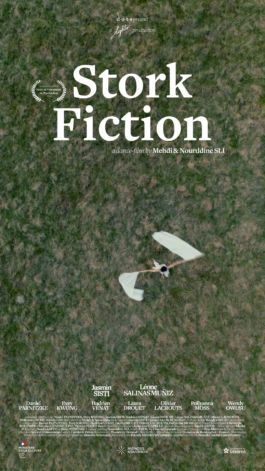





Happy to share that my work will be part of Vienna Design Week with an installation presenting a selection of works produced during this’s School of Phyto-centred Design organised by the Kunstgewerbemuseum Dresden. ROOM FOR CHANGE is an invitation to change perspective, question harmful agricultural practices, and look at plants as allies for militant and poetic design scenarios. Showcasing material experiments, fashion items, products, performances as well as videos and photos, the installation highlights the design and narrative potential of plants and reveals stories of interdependence, empowerment, resilience, but also exploitation, overconsumption, and colonization.
•
Other featured works by: Archeomaterico, Deborah Tina, Sahrajajarmikhayat, Anojish Kariano, Jaqueline Lobodda, Chi.makes.jewelry, Sujia Wang, morgennacht (art direction by Emma Bruschi) Kareem Goshan, Katoy Design, Benedikt Trojer (art direction by Fernando Laposse) / Natalia Milla / Katharina Ursula Mludek, Katrin Schwarz, Julia Sulikowska. Special thanks to Thomas Geisler for inviting us, and to Jasmin Schauer for the smooth coordination.
•
Image credit:
[1] Mah Meri girls get ready for dancing for tourists”, Carey Island, Bemboun Village, Carey Island, Malaysia, 1990, Jean Gaumy.*
[2–3] Leonie Hochstrasser
*This project is a non-commercial project. The pictures used are for educational and research purposes only.





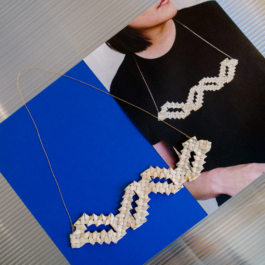



The Almanac exhibition is the inaugural research project of Fondation d’entreprise Martell, which, since its inception five years ago, is now evolving into a research and experimentation platform for art and design, as well as a space for raising awareness and learning – with a focus on living things.
This experimental initiative, which takes the form of an exhibition, residencies, encounters, and a living archive laboratory, emerged from a reflection on how a foundation located in a context that is rural yet industrial, prosperous yet remote, can establish itself as an agent for local dynamism and activate new potential for collective transformation. It soon became clear that the first step, before taking any action, would require the compilation of an inventory of the region’s resources and issues.
A team of designers was assigned with an investigative mission involving a wide range of local contacts (institutions, businesses, professional networks, and residents of Charente and Charente-Maritime), to identify local resources – natural and industrial, tangible and intangible.
The team led by Olivier Peyricot with Lola Carrel, Valentin Patis, and Mathilde Pellé, established an investigative methodology before embarking on the collection and analysis work.
The subjective view resulting from their observations is presented on the second floor of the Foundation. It offers an immersion into the collected samples, enabling visitors to rediscover significant materials and neglected deposits, living techniques, and forgotten know-how.
This multi-faceted and contributory project explores the processes of production and interdependence in order to better position itself as a tool and catalyst for transition, enabling the development of unique creative practices that bring about change. The aim is to create new imaginaries and chart new ways for building a resilient and equitable future.

Workshop/Teach + Talk
Eindhoven, NL
July 13–14, 2023
New Order of Fashion (NOoF) invites (aspiring) fashion design professionals to join us for an invigorating week-long programme exploring the knowledge and skills we need for a better fashion future!
The ‘Design for Change’ retreat addresses the contemporary issues fashion faces: on climate, environment, production, consumption, and wellbeing for people. Through a combination of theory and hands-on exercises, we’ll examine the various paths that can be taken to a cleaner, smarter and more caring fashion future.
Together with a stellar line up of international speakers, experts and workshop hosts, we will collectively investigate the overarching goal of sustainable and circular fashion design. The program includes topics and methodologies such as systemic thinking, local regeneration, material understanding & value, crafts, remake and repair skills, and building resilient communities.

futurprimitiv is very proud to have received a grant from the European Union. Over the next 3 weeks, i will be participating on a research project, ‘Rooted Craft’ in Loulé, initiated by Origem Comum and supported by Loulé Criativo.
‘Rooted Craft’ is a research project that explores rural crafts with a new approach to weaving techniques that were once a thriving economic activity for agricultural and transportation of goods, as well as for domestic use. With the scarcity of natural resources and environmental awareness, there is a resurgence of artisanal production, recovering ancestral technologies.
The resulting products answer the demand for more ecological consumption choices. With that in mind, this project looks to form new hybrid understandings of weaving, through know-how exchange and transfer and weaving archetypes research to open new possibilities for new applications. In result of these rich archives, they will be integrated in the ‘Situated Practices’ exhibition.

Group Exhibition
Salone del Mobile
Alcova – Viale Molise 62, Milan
Apr 17–23, 2023
We invite you to a celebration of 3 years of Basketclub during Salone del Mobile with a showcase of our highlights and the launch of a new book!
Basketclub was founded by Adrianus Kundert and Jamie Wolfond in 2020 as an Instagram-based initiative. The collective comprises crafty designers and artisans who respond to a monthly brief containing nothing but an emoji by weaving a “basket”. The finished baskets are photographed and shared online, showcasing a range of technical, aesthetic, conceptual, playful, political, and historical approaches from designers worldwide.
•
This exhibition is funded by Stimuleringsfonds and much supported by our basketclub members.








Feature works on publication, 2023
⭢ Link
Together with designers and crafts makers from diverse backgrounds (product, textile and graphic design, design anthropology, crafts making, etc.), I am thrilled to be part of this initiative as this way of working has shaped me the past years of my practice as a designer and my work methodology via acknowledging the history of low-tech crafts and the material design.
The instagram-based group Basketclub was founded during the pandemic by Dutch designer Adrianus Kundert and Canadian designer Jamie Wolfond with the idea of empowering experimental making during the difficult times. Each member of Basketclub weaves a basket based on an emoji.
To celebrate three years of Basketclub, and the 300+ baskets made for the project, the book was launched during Salone del Mobile last year. The baskets shown represent a range of different approaches, including technical, aesthetic, conceptual, playful, political, and historical. Each designer brings their unique fascination and cultural context to the theme.
•
The book, designed by Koos Breen, and edited by Adrianus Kundert has 312 full color pages with images of all the basketry projects and includes essays by Ed van Hinte, Adrian Madlener and Lois Walpole.





Crafts Research
Kapuas Hulu, West Borneo
Mar 20–Apr 1, 2023
There is so much to digest after departing from the recent Iban village I was at for a short 2-week trip. Often case, how one relates to the other is a lot to do with own’s past, upbringing and worldviews. One of the most significant things I’ve learnt from this research is how weaving has crossed my understanding on people, place and nature. It can be a manifestation of personal (and communal) journey with mythical meaning which opens another spectrum of how weaving could be understood.
I hope to be able to write more on these from my daily oral conversations with the local weavers, and with the support from researcher Hardiyanti.
#materialculture #basketry #wovencommunities #ibanculture #dayak #traditionalcustom #oralculture



Group Exhibition
World Design Capital Valencia
Sept 19–25, 2022
⭢ Link
Rattan is a humble material, but extremely rich in shades.
Obtained from the processing of certain species of climbing palms mostly found in Asia and Africa, rattan is fine, durable, sturdy while visually lightweight. Similar materials, such as wicker, esparto and cane, have been used since ancient times, especially in the rural environments, to produce both decorative and daily-life functional objects, such as baskets, espadrilles, mats, and seats. It has long been widely used in the field of design, too.
The exhibition features the results of the 1-week Summer workshop which took place at Domaine de Boisbuchet. During the workshop, we focused on rattan’s properties and explore all the different ways and possibilities to work with it, pushing it to its limits. Our hands will be very busy in weaving and bending, twisting and twining (with the help of a steamer at our side to shape our ideas).




Participants: Anton Rahlwes, Carla Alcalà Badias, Evey Kwong, Gonçalo Lopes Cardos, Isabel Alonso, Lucia Sanchis and Nic Holden.
Material sponsorship by Expormim. Photos by Nacho García.






The volume looks at human history through its details, and invites us to see design and architecture in new ways. Comprehensive and interdisciplinary, U-JOINTS is a collective project that brings together the voices and viewpoints of more than 120 authors. Together they “tell” design and architecture in the form of stories, essays, interviews, statements, visits to factories, reportage, facts and figures and, not least, a vast taxonomy of joints. Photo portfolios examine how joints are produced, illustrate their diverse uses, or simply show the inherent yet often overlooked beauty of connections in the man-made world.
Editors: Andrea Caputo, Anniina Koivu
Editorial team: Margherita Banchi, Marta Pezzoli
Senior researcher: Eleonora Castellarin
Design: Graphic Thought Facility
Printed and bound by: Musumeci Spa
Publisher: SYNC-SYNC Editions

U-Joints – Knots & Knits is a glimpse into the manifold possibilities of intrinsic connections, unravelling the history of textiles, fabrics and ropework. Whether used in rigging, for lifting heavy objects, wrapping a lunch box or closing a gift, securing a funambulist’s highwire, keeping a climber from falling off a wall or creating adventurous playgrounds for children, knots are considered the oldest and most basic technique of joinery. Bridges, bamboo scaffoldings, fishing nets: all kinds of structures can trace their origins to the simple gesture of pulling a string through a loop. Knitting, in turn, creates anything from clothing to car interiors to entire architectural structures. When strings are intricately crossed, woven patterns are born. In the form of upholstery weaves, they lend comfort to our sofas, can buffer noise or explode into life-saving airbags. Electric cables, airplane wings and morphing membranes for vascular prostheses can be woven. Clothing and home textiles are unimaginable without weaving. ⭢ Read more




The whisk brooms from my crafts research has found its new home in the Berlin State Museum collection. In conjunction to the upcoming exhibition All Hands On: Basketry, the brooms will be showcased along with the impressions of my past learning experiences with Carlos Fontales (ES), Serfenta (PL), Margrit Linder (CH) and in Borneo.
From top to bottom: Brooms techniques found from Habkern, Uri and Murcia. Made by Evey Kwong. © Staatliche Museen zu Berlin, Museum Europäischer Kulturen, Christian Krug

An initiative of Crafts Council Nederland in collaboration with Adrianus Kundert, designer and co-founder of Basketclub.
HOW&WOW BASK IT! – or ‘treasure it’ – will transport you into the world of basketry and reveal the numerous aspects of three dimensional weaving: the specific characteristics, creative techniques, new implementations, cultural exchange and nature conservation. Basket weaving is a 3D-construction technique allowing the maker to create a three dimensional shape using their own hands and just a few tools. The craft, and also its importance, have undergone changes through time. Few people realise that all woven baskets, furniture and accessories are still made by hand, including those sold by the well-known retail chains. Lack of appreciation for this time consuming technique has resulted in it now rarely being practiced in the western world. It is particularly important to focus on the unique characteristics of hand made products in the current era of globalisation, digitalisation and robotics. Craftsmanship is satisfying work, makers are in control of what they produce and are able to express their individuality. It is no surprise that the online community Basketclub arose during the pandemic.
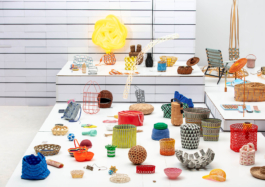
Participants: Adrianus Kundert, Amandine David, Anaïs Godefroy, Bertjan Pot, Carole Baijings, Chris Kabel, Christopher Specce, Clara von Zweigbergk, dach&zephir, Earnest Studio, Emma Cogné, Esmé Hofman, Esther van Schuylenbergh, Evey Kwong, Fango, Garth Roberts, GREATMINOR, Hella Jongerius, Hsiao Fong, Ief Spincemaille, Ineke van der Sommen, Jamie Wolfond, Joris van Tubergen, Léa Mazy, Lenny Stöpp, Lois Walpole, LouCruard, Mae Engelgeer & Ames, Mandenmakerij de Mythe, Michael Schoner, Nathalie Miebach, Nationaal Vlechtmuseum Noordwolde, Rebecca Collins, Rein Reitsma, Renaud Defrancesco & Anne Bertoncini, Rik van Veen, Rob van Hernen, Samy Rio, SCMP DESIGN OFFICE, Sebastian Herkner, Shigeki Fujishiro, Simone Post, Studio Satël, Tamara Orjola, Thomas van der Sman and Yuki Hidano.
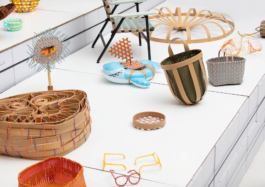
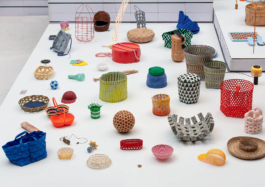
Team Crafts Council Nederland: Marion Poortvliet, Willemien Ippel & Guusje Heesakkers
Curator: Adrianus Kundert
Graphic design: Daniël Maarlevel
Photo credit: Fan Liao
HOW&WOW BASK IT! is financially made possible by Creative Industries Fund NL, Prins Bernhard Cultuurfonds and Dedon.

The origin of this technique derives from the Bornean ‘Bekang Kerawang’, a burden basket typically used for carrying agricultural harvest and game. As a presumption, this technique is introduced based on the needs to construct a rigid (non-organic in form) quadrilateral plane, suited to use them as frames to construct a cuboid container.
